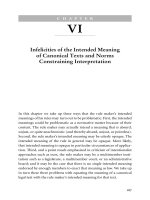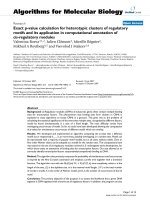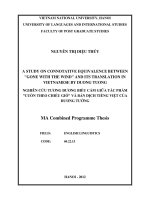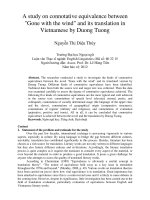Dismembering appearances the cultural meaning of the body and its parts in eighteenth century understanding
Bạn đang xem bản rút gọn của tài liệu. Xem và tải ngay bản đầy đủ của tài liệu tại đây (2.7 MB, 314 trang )
This thesis has been submitted in fulfilment of the requirements for a postgraduate degree
(e.g. PhD, MPhil, DClinPsychol) at the University of Edinburgh. Please note the following
terms and conditions of use:
This work is protected by copyright and other intellectual property rights, which are
retained by the thesis author, unless otherwise stated.
A copy can be downloaded for personal non-commercial research or study, without
prior permission or charge.
This thesis cannot be reproduced or quoted extensively from without first obtaining
permission in writing from the author.
The content must not be changed in any way or sold commercially in any format or
medium without the formal permission of the author.
When referring to this work, full bibliographic details including the author, title,
awarding institution and date of the thesis must be given.
Dismembering Appearances: The Cultural Meaning
of the Body and its Parts in Eighteenth-Century
Understanding
Submitted in Fulfilment of the Requirements for the Degree:
Doctor of Philosophy
to the
University of Edinburgh
by
Kathryn Woods
s0563446
Doctoral Student of History
Department of History, Classics and Archaeology
University of Edinburgh
2014
Abstract
This thesis explores the cultural meanings attached to the visible appearance of the
body and its parts in eighteenth-century understanding. It is situated within historical
scholarship concerned with the embodied display of ‘politeness’ and the relationship
between the body and categories of social difference. The research draws upon a
range of popular literature, including conduct books, popular medical advice books,
midwifery manuals and advice guides.
Chapter one reveals the way that contemporaries conceptualised the
relationship between the individual body and society through investigation of various
aspects of abdominal experience. Chapter two illustrates how the appearance of the
skin was thought to convey identity information about an individual’s health,
temperament, character, gender, class and race. Chapter three then continues by
exploring similar themes with respect to the face. The next two chapters focus on the
corporeal display of gender; while chapter four argues that changing male and female
hairstyles reflected shifting gender mores, chapter five evidences how female breasts
were seen as visible markers of sexual difference. Chapter six examines how class
informed how the hands were employed and displayed by different social actors.
Finally, chapter seven looks at how ‘politeness’ informed how the legs were trained to
enact various cultural performances.
In this thesis it is argued that in the eighteenth century popular authors sought
to uncover how bodies worked by appropriating anatomical models of examining the
body through scrutiny of its parts. Yet, it will be demonstrated that discussion of the
body’s parts within popular literature was distinctive because it reflected readers’
growing preoccupation with how the body, as a social actor, conveyed information
about individual identity.
The thesis contributes to present scholarship by detailing a range of meanings
which were attached to different parts of the body that have previously been elided by
historians. Additionally, it demonstrates that discursive dismemberment, though
located in eighteenth-century discourses on the body, represents a historically
reflective and methodologically useful mode of examining the lived body in the
eighteenth century.
2
Contents
Declaration of Authorship
Acknowledgements
List of Illustrations
Conventions
6
7
8
9
Introduction
The ‘Polite’ Body
‘Politeness’ and Embodied Display
The Body and Social Difference
Theoretical Considerations and Methods
Aims and Objectives
Introduction to the Sources
Chapter Outline
10
12
17
22
27
28
42
1. Digestion and Body Size
Introduction
Humours, Organs, Blood and the Stomach
Popular Medical Advice Books and the ‘Regimens’
Temperance
‘Corpulency’
Fatness and Leanness
Body Size, Gender and Fertility
Shape, Class and Nationality
Conclusion
45
47
51
56
59
61
66
69
72
2. Skin
Introduction
A Shifting Anatomical Boundary
Complexion
‘Beautiful’ Complexions
Skin Colour and Social Difference
A Surface of Inscription
Conclusion
74
76
81
84
87
95
101
3. Face
Introduction
Physiognomy
Facing the ‘Polite Self’
Beauty
Ugliness
Expressing ‘Politeness’
Cosmetics and the ‘Picts’
Conclusion
102
104
112
115
121
126
135
139
3
4. Hair and Head
Introduction
Gendering the Head
Colours and Humours
Colour, Texture, Climate and Inheritance
Periwigs and the Measure of the Man
Towering Coiffures and Female Character
Conclusion
141
142
146
153
158
161
165
5. Breasts
Introduction
Growing Breasts
Age, Sex and the Appearance of the Breast
‘Beautiful’ Breasts
Modest forms of Display
Nursing Breasts
Conclusion
167
168
173
176
180
184
189
6. Hands
Introduction
Palms and Palmists
Thumb and Fingers
Nails
‘Beautiful’ Hands and Social Difference
Rights and Lefts
‘Airs’ and Performance
Conclusion
190
191
195
198
202
206
209
215
7. Legs and Feet
Introduction
Proportion and Social Categorisation
‘Fitness’
Stepping Out ‘Politely’
Living with Deformity and Disease
Conclusion
216
217
223
229
237
241
Conclusion
242
Appendix
Courtesy Texts
Medical Advice Books
Midwifery Texts
Advice Books
250
251
265
274
280
4
Bibliography
Primary Sources
Secondary Sources
287
301
5
Declaration of Authorship
I, Kathryn Woods, hereby declare that this thesis has been composed by myself and
the work in it is entirely my own. The work has not been submitted for any other
degree or professional qualification except as specified. Signed:
6
Acknowledgements
In writing this PhD I have found myself indebted to the many people who have
generously given up their time, energy, expertise, and often patience, to help me
along the way. My first debt is due to my excellent supervision team: Professor Stana
Nenadic and Dr Gayle Davis. I thank them for their belief in the project and
encouragement of all my various ventures into academia. I feel extremely lucky to
have benefited from the backing of two such impressive female role models at this
early stage of my career.
Particular acknowledgment is also due to several members of Edinburgh
University’s History department. Firstly, I offer my gratitude to Dr Adam Fox for his
work as my undergraduate supervisor and for the insightful commentary he offered at
my first year review. Thanks are also due to Dr Adam Budd for his help in formulating a
proposal for this research in its very early stages. More generally I wish to
acknowledge my appreciation to my school for the Arts and Humanities Research
Council funding they bestowed upon me to facilitate this research. Additionally, I want
to thank all of those who work so hard to create such a great research ethos within the
school, and all the undergraduates I have had the pleasure of teaching in the last three
years.
My final thanks are personal ones. To my Glenfinlas colleagues I express my
gratitude for the fresh perspectives that their many artistic and academic interests
have brought to my research, as well as the constant supply of good-cheer and coffee.
I similarly thank the London girls, my flat-mates, fellow heritage project volunteers,
and other chums, for all the welcome distractions they have offered over the years,
and their constant willingness to have their ears bent.
However, my ultimate and most important thanks go to my Mum and Dad,
Helen and Kevin. I thank you directly for your constant love, support, and
encouragement. At this stage I am even grateful for the nagging! I really could not
have done it without you.
7
List of Illustrations
1. An image of the face illustrating the influence of the different signs of the zodiac,
from Anon., Aristotle’s Compleat Masterpiece (London, 1697).
2. Resemblance of a man to a lion, from G. B. della Porta, On Human Physiognomy
(Naples, 1586).
3. Types of mouth, from J. C. Lavater, Essays on Physiognomy, volume three (London,
1789).
4. Patches on a white face and on that of black “savage”, from J. Bulwer,
Anthropometamorphosis (London, 1653).
5. ‘New Head Dresses for the Year 1770’, from D. Ritchie, Treatise on the Hair (London,
1770).
6. Illustration showing the names of the lines of the hand, from E. Pater, The Book of
Knowledge Shewing the Wisdom of the Achievements of the Ancients (London, 1720).
7. ‘To Give or Receive’, from F. Nivelon, The Rudiments of Genteel Behaviour (London,
1737).
8. ‘Rhetorick’, R. Cesare, Iconologia: or, Moral Emblems (London, 1709).
9. ‘The Laplander’, from O. Goldsmith, An History of the Earth, and Animated Nature,
volume two (London, 1790).
10. ‘Young Tree Moulded into Shape’, from N. Andry, Orthopӕdia; or the Art of
Correcting and Preventing Deformities in Children (London, 1743).
11. ‘Standing’, from F. Nivelon, Rudiments of Genteel Behaviour (London, 1737).
12. Dance Steps, from F. Raoul-Auger, The Art of Dancing (London, 1706).
8
Conventions
Note on the Text
Throughout this thesis, original spelling, punctuation, italicisation, capitalisation and
word abbreviation has been retained in quotations from the primary source material.
This is why the spelling of many words in the quotations is inconsistent. In instances
where the contemporary words and spellings are unfamiliar to modern readers,
definitions will be provided in the footnotes.
Printed Book Formats
Folio
Quarto
Octavo
Duodecimo
Decimo-sexto/sixteenmo
Decimo-octavo/eighteenmo
1 leaf = 2 pages
4 leaves = 8 pages
8 leaves = 16 pages
12 leaves = 24 pages
16 leaves = 32 pages
18 leaves = 36 pages
(4o)
(8o)
(12o)
(16o)
(18o)
Currency
1 shilling (1s) = 12 pence (12d)
I pound (£1) = 20 shillings (20s)
I guinea = 21 shillings (21s., or £1. 1s)
9
Introduction
The ‘Polite’ Body
The world has long since decided the Matter…People where they are not known,
are generally honour’d according to their Cloaths and other Accoutrements they
have about them; from the richness of them we judge of their Wealth, and by the
ordering of them we guess at their Understanding. It is this which encourages
every body, who is conscious of his little Merit, if he is any ways able, to wear
Cloaths above his Rank, especially in larger and Populous Cities, where obscure
men may hourly meet with fifty Strangers to one Acquaintance, and consequently
have the Pleasure of being esteem’d by a vast Majority, not as what they are, but
what they appear to be.1
In The Fable of the Bees (1714), the plain-speaking Bernard Mandeville observed that
dramatic population growth and commercialisation was transforming many British
communities into large anonymous settlements where a person’s identity could often
only be identified by their appearance. Yet, many ‘polite’ social commentators
believed that the trust which society vested in appearances was misplaced as they
considered looks to be deceptive. The leading arbiters of politeness certainly proposed
that manners, as displayed by actions and behaviour, should be used as a measure of
character rather than external appearances. In The Spectator, it was observed:
It is an irreparable Injustice we are guilty of towards one another, when we are
prejudiced by the Looks and Features of those whom we do not know. How
often do we conceive Hatred against a Person of Worth, or fancy a Man to be
proud and ill-natured by his Aspect, whom we think we cannot esteem too much
when we are acquainted with his real Character?2
So what, contemporary readers must have pondered, really was the best
measure of character: looks or actions? In The Polite Lady (1760), Charles Allen
revealed how contemporaries wrestled with the contradictions between what popular
‘polite’ discourse instructed and the reality of their own lived experiences. In doing so,
Allen gave away what the elite actually thought about appearances. Although
presenting himself as ‘no great friend’ to ‘the judging of people’s characters by their
1
2
B. Mandeville, The Fable of the Bees (London, 1714), p. 103.
th
J. Addison & R. Steele, The Spectator, No. 86 (8 June 1711).
10
looks’, Allen admitted that he believed there was at least ‘something in it.’3 Hence, he
informed his fictional daughter: ‘it concerns every young lady to be very careful of her
looks, since her character depends as much on these as any other part of her
behaviour.’4
Comparison of these views evidences that there were many contrasting
opinions about what the appearance of the visible body revealed about individual
identity in the eighteenth century. Yet, in spite of their differences of opinion, one
feature that all these discourses shared was the way they sought to detail the uses and
meanings of the body through analysis of its parts. The research here will illustrate
that this process of discursive dismemberment was employed as it enabled authors to
investigate how different parts of the body worked in conjunction with the corporeal
whole and to outline what a person’s appearance suggested about their identity. It will
be argued that this process also permitted writers to discuss openly what looks
indicated about character, while appearing loyal to the ‘polite’ assertion that people
should not be judged on external appearances.
By replicating the method these authors employed and analysing discursive
representations of the body’s parts, this research will uncover the multiplicity of ways
identity was believed to be stamped on corporeality in popular thought. However,
before commencing this investigation it will be essential to provide some explanation
of the historical and historiographical contexts that have informed the construction of
this project. This introduction will therefore proceed by exploring the contours of
historical scholarship concerning ‘politeness’ and embodied display in elite culture. It
will then look at how the body and categories of social difference have been examined
by eighteenth-century historians. Next, it will explain some of the methodological
considerations that have guided the formulation of this research and provide an
introduction to the sources. Finally, it outlines the main aims of this thesis and how
they are addressed in later chapters.
3
4
C. Allen, The Polite Lady; or a Course of Female Education (London, 1760), p. 217.
Ibid, p. 219.
11
‘Politeness’ and Embodied Display
In the last thirty years ‘politeness’ has assumed an important place in historical
interpretations of eighteenth-century British culture. In its most basic formulation
‘politeness’ is defined as a set of behaviours concerned with the display of form,
sociability, improvement, worldliness and gentility, which informed the nature of
inter-personal interaction in eighteenth-century Britain.5 Lawrence Klein asserts that
as a code of behaviour politeness primarily involved the display of socially agreed
forms of ‘decorum in behaviour and personal style.’ He adds: ‘Proponents of
politeness frankly acknowledged the necessity, even the virtue, of social artifice’.6
Nonetheless, politeness was much more than mere etiquette. Instead, politeness
represented an all-embracing philosophy of social behaviour that promoted openness
and accessibility within society, but which at the same time set demanding
prescriptive standards of how precisely people should behave towards one another.7
The emergence of politeness was synonymous with many of the political,
economic and social changes occurring in eighteenth-century Britain. To begin with,
politeness was a form of social behaviour that was necessitated by the removal of high
culture out from the ‘narrow confines of the court’, and its relocation in a range of
new and diverse social spaces developing in London from the late seventeenth
century.8 Counting among these social spaces were assembly halls, coffee-houses,
debating clubs, theatres, galleries, gardens and concert halls. Whilst at the beginning
of the period these spaces appeared only in London, over the course of the century, as
part of the ‘English urban renaissance’, they emerged in provincial urban centres all
over Britain.9 This served in extending the geographical remit of the elite’s
engagement with high culture and provided the elite living in many different areas
with shared forms of cultural experience.
The development of the public sphere offered the elite opportunities for new
forms of social engagement and display. John Brewer argues: ‘from the individual’s
5
L. Klein, ‘Politeness and the Interpretation of the British Eighteenth Century’, The Historical Journal,
45:4 (2002), p. 877.
6
Ibid, p. 874.
7
M. Snodin & J. Styles (eds), Design and the Decorative Arts: Britain, 1500-1900 (London, 2001), p. 183.
8
J. Brewer, The Pleasures of the Imagination (New York, 1997), p. 3; R. H. Sweet, ‘Topographies of
th
Politeness’, Transactions of the Royal Historical Society, 6 series, 12 (2002), pp. 355-74.
9
P. Borsay, The English Urban Renaissance: Culture and Society in the Provincial Town (Oxford, 1989),
pp. 270-1.
12
point of view, access to culture and self-presentation in the cultural arena was a vital
means of maintaining or attaining social status and of establishing social
distinctions.’10 In this mode, politeness was a form of behaviour of use to the
traditional landed elites of the aristocracy and gentry, as well as prosperous groups of
merchants, bankers and industrialists, and members of the emergent professional
classes, including physicians, lawyers, army and navy officers, and civil servants.11 In
addition, it is argued that many members of the lower middling sorts, including
shopkeepers, farmers, country curates, book-sellers and inn-keepers, would have
aspired to be considered ‘polite’ and to participate in ‘polite’ cultural
entertainments.12 Accordingly, politeness was a form of behaviour with various social
uses for a wide range of social actors.13
Women also featured as prominent members of polite society. This was
because their presence was considered essential for encouraging sociability and
tempering more disagreeable characteristics of male discussion.14 However, women
were not just passive participants in elite society. Rather, they assumed important
positions of authority in the organisation of activities enacted within polite social
settings.15 Afforded this prominence in elite society it has been shown that women
used politeness to achieve their own ends. Illustrating this, Elaine Chalus argues that
10
J. Brewer, ‘The Most Polite Age and the Most Vicious: Attitudes towards Culture as a Commodity
1600-1800’, in A. Bermingham & J. Brewer (eds), The Consumption of Culture 1600-1800 (London & New
York, 1995), p. 348.
11
Klein, ‘Politeness and the Interpretation of the British Eighteenth Century’, p. 873; C. Saumerez Smith,
Eighteenth-Century Decoration: Design and the Domestic Interior in England (London, 1993), p. 45;
Snodin & Styles, Design and the Decorative Arts, p. 180; P. Corfield, Power and the Professions in Britain
1700-1850 (London & New York, 1995); P. Langford, ‘The Uses of Eighteenth-Century Politeness’,
Transactions of the Royal Historical Society, Sixth Series, 12 (2002), p. 318; A. Vickery, The Gentleman’s
Daughter: Women’s Lives in Georgian England (New Haven & London, 1998), pp. 23, 196; P. Earle, The
Making of the English Middle Class: Business, Society, and Family Life in London 1660-1730 (New Haven
and Los Angeles, 1989), pp. 5-9.
12
Langford, ‘The Uses of Eighteenth-Century Politeness’, pp. 318-22; Earle, The Making of the English
Middle Class, pp. 1-5; L. Klein, ‘Politeness for Plebs: Some Social Identities in Early Eighteenth-Century
England’ in Bermingham and Brewer (eds), The Consumption of Culture, p. 364.
13
Klein, ‘Politeness and the Interpretation of the British Eighteenth Century’, p. 873.
14
S. Tomaselli, ‘The Enlightenment Debate on Women’, History Workshop Journal, 20: 1 (1985), pp. 101124; M. Cohen, ‘“Manners” Make the Man: Politeness, Chivalry and the Construction of Masculinity
1750-1830, Journal of British Studies, 44: 2 (2005), p. 313.
15
K. Glover, Elite Women and Polite Society in Eighteenth-Century Scotland (Woodbridge, 2011), p. 4.
13
by embracing politeness women were able to participate in masculine activities, such
as politics, from which they were usually debarred.16
In recent years politeness has been employed by scholars as an analytical
category to investigate the display, regulation and representation of the body in elite
culture. This research has developed along three main lines of inquiry. The first has
sought to investigate the social and behavioural aspects of politeness as it was
manifested in the presentation and regulation of the body. This scholarship owes a
significant debt to Norbert Elias. Through analysis of a range of courtly conduct
literature Elias showed that in Europe from the late medieval period through to the
nineteenth century, individuals increasingly denied their natural bodily impulses in the
name of civility and for the purposes of state formation.17 More recently this subject
has been taken up by Anna Bryson. Although assuming Elias’ model in a general sense,
Bryson critiques his idea of a linear development in terms of the regulation of the body
over several centuries. In opposition, she proposes that the actions of the body in the
early modern period were regulated in particular ways in distinctive social settings for
specific social purposes.18
The embodied display of politeness has been most thoroughly excavated by
historians in relation to the experiences of women. This is because it has been shown
that bodily regulation and the correct display of embodied comportment was socially
facilitating for women at this time.19 Ingrid Tague has identified this situation in the
ways that women’s natural characteristics were presented in conduct literature. She
suggests that the behavioural models of femininity outlined in these works caused
women to become aware that their adherence to these modes of behaviour was
imperative for securing their position within polite society.20 Brigitte Glaser proposes
that this was the same reason why eighteenth-century educational treatises for girls
16
E. Chalus, ‘Elite Women, Social Politics, and the Political World of Late Eighteenth-Century England’,
The Historical Journal, 43: 3 (2002), pp. 669-97.
17
N. Elias, The Civilisng Process: The History of Manners and State Formation and Civilisation (Oxford,
1994). Über den Prozess der Zivilisation was first published in 1939. It was translated by Edmund
Jephcott as The Civilising Process and published in two books in 1978 and 1982.
18
A. Bryson, From Courtesy to Civility: Changing Codes of Conduct in Early Modern England (Oxford,
1998), pp. 96-103.
19
L. Klein, ‘Gender, Conversation and the Public Sphere in Early Eighteenth-Century England’, in J. Still &
M. Worton (eds), Textuality and Sexuality: Reading Theories and Practices (Manchester, 1993), p. 108.
20
I. Tague, Women of Quality: Accepting and Contesting Ideals of Femininity in England 1690-1760
(Woodbridge, 2002), p. 22.
14
placed much more emphasis on the education of the body than those aimed at boys,
which primarily focused on the cultivation of the mind.21
Other historians have looked at how the display of embodied manners changed
over the course of the century. Michael Curtin and Philip Carter propose that in
courtesy texts which set forth the idealised qualities that a man or woman must
possess in terms of their interests, social activities, education and conduct, morals and
manners were presented as being mutually reinforcing.22 However, from the 1760s the
courtesy genre fell into gradual decline. Some scholars argue that this was due to a
‘sentimental revolution’ which transpired because contemporaries increasingly found
‘politeness’ a hollow and routinized system of manners devoid of any real moral
value.23 Others suggest that the decline of the courtesy genre, and the models of
politeness it presented, was brought about by alterations in cultural notions of
masculinity and femininity. John Tosh argues that ‘politeness’ became increasingly
irrelevant for men in the late eighteenth century as a result of the changing ‘core
values’ of national masculinity.24 Similarly, Marjorie Morgan observes that courtesy
books for women published after 1770 were much more concerned with women’s
moral virtues than their external manners, indicating changing notions of femininity.25
Another strand of scholarship concerning the relationship between the body
and politeness examines clothes and decorations worn upon the body. In her analysis
of eighteenth-century clothing, Aileen Ribeiro explicitly links fashions for particular
sorts of clothing with aspects of politeness. Adding a corporeal dimension to her
research she proposes that it was considered equally essential to ‘achieve the correct
shape in figure, accentuated with carefully chosen clothes and accessories’. 26 The
abridgement between the corporeal and material display of politeness has likewise
21
B. Glaser, ‘Gendered Childhood’s: On the Discursive Formation of Young Females in the Eighteenth
Century’, in A. Müller (ed.), Fashioning Childhood in the Eighteenth Century: Age and Identity
(Burlington, 2006), pp. 189-198.
22
P. Curtin, ‘A Question of Manners, Status and Gender in Etiquette and Courtesy’, Journal of Modern
History, 57, 3 (1985), p. 405; P. Carter, ‘Polite “Persons”: Character, Biography and the Gentleman’,
th
Transactions of the Royal Historical Society, 6 series, 12 (2002), p. 355.
23
P. Langford, A Polite and Commercial People, England 1727-1783 (Oxford, 1989), pp. 462-467; Curtin,
‘A Question of Manners’, pp. 395-425.
24
J. Tosh, ‘Gentlemanly Politeness and Manly Simplicity in Victorian England’, Transactions of the Royal
Historical Society, Sixth Series, 12 (2002), pp. 455-472.
25
M. Morgan, Manners, Morals and Class in England 1774-1858 (New York, 1994), p. 10.
26
A. Ribeiro, Dress in Eighteenth-Century Europe (New Haven & London, 2002), p. 171.
15
been highlighted in scholarship concerning hair and wigs. Marcia Pointon argues that
recognition of the symbolic power of the body is essential for understanding the
significance of the wig as a signifier of masculine authority. She asserts that ‘the wig’s
prevalence as a major item for male attire for over a hundred years’ must be
understood ‘within the context of self-enactment that served to define masculinity
politically and culturally.’27
Historians have also examined the use of cosmetics in elite society and how
they were used to display socially facilitating forms of identity information. In her
recent work on beauty and cosmetics Riberio argues that the use of these products
enabled women to demonstrate their knowledge of fashion and to display beauty,
which allowed them to empower themselves socially.28 Conversely, Tassie Gwilliam
shows that women’s use of cosmetics was often viewed with suspicion by men
because of the way these products were believed to allow women to construct their
own identities.29 Material products, such as clothing, wigs and cosmetics, have thus
been shown to have been used to extend the symbolic power vested in particular
parts of the body in elite culture.
A final strand of investigation concerning the relationship between the body
and politeness looks at representations of the body in a range of discursive and visual
artefacts. Some scholars have used this approach to examine the limitations and
paradoxes of politeness. This is illustrated in Vic Gatrell’s study of satirical imagery. His
analysis shows that far from seeking to distance themselves from the body’s more
vulgar natural functions, the elite revelled in things like bum and fart humour.30
Likewise, Karen Harvey has tackled the tricky issue of the relationship between
sexuality and ‘politeness’ through an examination of the representations of the body
in a range of erotic texts. She argues that by cloaking erotic descriptions of the body in
complex botanical metaphors, the authors of these works created a decorous distance
between the reader and the text. This, she proposes, allowed readers seemingly to
27
M. Pointon, ‘The Case of the Dirty Beau: Symmetry, Disorder, and the Politics of Masculinity’, in K.
Alder & M. Pointon (eds), The Body Imaged: The Human Form and Visual Culture Since the Renaissance
(Cambridge, 1993), p. 188.
28
A. Ribeiro, Facing Beauty: Painted Women and Cosmetic Art (New Haven & London, 2011), p. 140.
29
T. Gwilliam, ‘Cosmetic Poetics: Colouring Faces in the Eighteenth Century’, in V. Kelly & D. Meucke
(eds), Body and Text in the Eighteenth Century (Stanford, 1994), p. 144.
30
V. Gatrell, City of Laughter: Sex and Satire in Eighteenth-Century London (London, 2006), pp. 178-209.
16
champion the emphasis which politeness placed on behavioural self-control, while at
the same time enjoying the sexual gratification that these texts offered.31
Consequently, it has been demonstrated that politeness did not purge the body’s
natural functions and impolite actions from elite culture, but rather mutated how they
were presented in a variety of cultural forms.
The Body and Social Difference
The last thirty years has witnessed a substantive rise in historical interest in the body.
Body-based research owes its genesis to Bryan Turner who, in The Body and Society
(1984), explicitly presented the body as a subject of analysis for social scientists.
Turner opened his work with the assertion: ‘There is an obvious and prominent fact
about human beings: they have bodies and they are bodies’.32 Despite this ‘obvious
fact’, Turner observed that few social theorists had previously investigated, or taken
seriously, issues concerning embodiment or the body’s role in forms of social
interaction.33 In Turner’s opinion this was a serious oversight because he argued that
the body plays a central role in all forms of social interaction as it is the basis of all
human action. Through his work Turner thus formulated a new agenda for social
science, with the body as an essential theoretical and methodological problem at its
centre.
As many recognised the value in Turner’s assertions, the body quickly became a
subject of interest for scholars working on an assortment of disparate areas of history.
This is brought into focus in one of the first collected editions on the subject of the
body: Micheal Feher, Romona Naddaff and Nadi Tazi’s Fragments for a History of the
Human Body (1989). This substantial work, consisting of forty-eight papers written by
a variety of European scholars, presented a range of approaches for examining how
the body has been conceptualised and treated in different cultures at different times.
While several contributors spoke about the body as a biological or physical entity,
others presented it as a boundary or source of definition in a discursive, linguistic or
31
K. Harvey, Reading Sex in the Eighteenth Century: Bodies and Gender in English Erotic Culture
(Cambridge, 2004), pp. 1-2.
32
B. Turner, The Body and Society: Explorations in Social Theory (London, 1984), p. 1.
33
Ibid, pp. 60-63.
17
metaphorical sense.34 Although in some cases the body was conceptualised as an
object, in others it was presented as an agent for social action or resistance. Authors
who contributed also addressed different sorts of bodies, including those that were
live, dead, ‘heavenly’, ‘divine’ and ‘ghostly’, distinguished by their ‘gender’, ‘race’ or
‘class’, and branded as ‘diseased’, ‘beautiful’, ‘monstrous’, or ‘ugly.’ Conversely, some
chose not to examine the body as a whole, but rather focused on one of its different
parts: stomach, bowels, face, breasts and feet. This collected edition consequently
evidenced that the body could usefully be examined in a vast variety of different ways,
and since its publication body scholarship has diversified in a plethora of directions.
Despite the diversity of research that has been conducted under the banner of
‘the body’, within eighteenth-century body scholarship some general dominating
trends and themes of investigation have emerged. To start with, a vast quantity of
research on the ‘body’ has been concerned with issues relating to ‘sex’ and ‘gender’. 35
This situation has occurred as many scholars have encountered the body through
Thomas Laqueur’s seminal Making Sex (1990). In this work Laqueur charts the
transition from a ‘one-sex’ to a ‘two-sex’ understanding of the body in the eighteenth
century. He proposes that for hundreds of years male and female bodies were
understood as variants of one singular model of the body, where sexual distinctions
were imagined only as differences of degree. This situation, he argues, is most clearly
illustrated in the way female sexual organs were considered inverted versions of the
male.36 Laqueur proposes that this conception of the body enabled flexibility in the
cultural construction of gender. He attests that at this time: ‘sex or the body was the
epiphenomenon, while gender, what we would take to be a cultural category, primary
or real.’37
However, it was during the eighteenth century, Laqueur asserts, that the ‘twosex’ model of sexual difference achieved hegemony. Increasingly men and women
were organised along a horizontal axis which emphasised the anatomical differences
between them. In this understanding, sexual difference was not of degree, but rather
34
I. Culianu, ‘A Corpus for the Body’, The Journal of Modern History, 63:1 (1991), p. 61.
C. Bynum, ‘Why all the Fuss about the Body? A Medievalist’s Perspective’, Critical Inquiry, 22 (1995),
p. 5.
36
Laqueur, Making Sex, p. 4.
37
Ibid, p. 8.
35
18
fundamental and grounded in nature. Correspondingly, perceived differences in the
reproductive organs became the foundation for understandings of sexual difference. 38
Laqueur proposes that these understandings, derived from changing medical and
scientific views about the body, provided the basis for new ideas about gender
difference which coagulated cultural disparities between the societal roles of men and
women. Summarising the shift, one commentator notes: ‘Gender, the behaviour and
cultural attributes of masculinity and femininity collapsed into sex, that is, into the
physicality inscribed in the body of every individual’.39 The development of the twosex model thus not only saw the creation of increasingly solidified notions of
embodied difference between men and women, but also a radical change in the
relationship between the body and gender.
Since its publication some aspects of Laqueur’s thesis have been criticised. A
particularly important aspect of this critique concerns Laqueur’s argument that
between 1650 and 1800 there was a clear shift where the ‘world of one-sex’ gave way
to the ‘world of two’. Harvey has criticised Laqueur’s over-simplified account of this
change, emphasising the persistence of a more complex multitude of ideas throughout
this period which simultaneously emphasised sameness and difference.40 For other
scholars it is Laqueur’s denial of science and medicine as having played a significant
role in the inaction of changing views of the body that is problematic.41
Laqueur’s work has nevertheless stimulated a surge of academic interest in the
relationship between the body and gender. One line of this research usefully
investigates the parallels between medical representations of the body and cultural
notions of gender. Ludmilla Jordanova examines the relationship between gender and
the body through investigation of enlightened medical and scientific texts, along with
various images and artefacts, that conveyed forms of knowledge about the female
body. She shows how the representations of the female body that emerged from
38
Ibid, p. 149.
D. Wahrman, The Making of the Modern Self: Identity and Culture in Eighteenth-Century England
(New Haven & London, 2004), p. 44.
40
K. Harvey, ‘The Substance of Sexual Difference: Change and Persistence in Representations of the
Body in Eighteenth-Century England’, Gender and History, 14 (1996), pp. 202-3.
41
K. Park & R. Nye, ‘Destiny is Anatomy, Review of Thomas Laqueur, Making Sex: Body and Gender from
th
the Greeks to Freud’, New Republic (18 February, 1991), pp. 53-7.
39
19
these cultural products reflected contemporary notions of gender.42 Londa Schiebinger
also argues that mid-century representations of male and female skeletons, which
emphasised their physical differences, mirrored male desires to justify gender
inequalities within the liberal social framework of the Enlightenment.43
Laqueur’s narrative of sexual difference has also been incorporated into studies
of gender. In this mode, gender historians have been able to appropriate Laqueur’s
account of the body to support their ‘separate spheres’ theory which, until relatively
recently, dominated gender-based research.44 Illustrating this situation, Ruth Perry
argues that in the eighteenth century non-productive forms of female sexuality were
displaced by women’s re-definition as maternal rather than sexual beings.45 Likewise,
Tim Hitchcock has linked changing ideas about the female body to the way that
women were increasingly resigned to the private sphere of the home and domestic
‘maternal’ tasks such as bearing and nursing children, and the growing importance of
men’s sexual roles within the family as sexual partners and fathers.46
In recent years, emphasis on the relationship between gender and the body
has been replaced with a scholarly interest in the connections between the body and
sexuality.47 One commentator has even gone so far as to name the body ‘as the
subject of the sexual sciences.’48 Scholars working in this area have sought to examine
a much wider variety of embodied themes than were explored in earlier forms of
42
L. Jordanova, Sexual Visions: Images of Gender in Science and Medicine between the Eighteenth and
Twentieth Centuries (New York & London, 1989).
43
L. Schiebinger, ‘Skeletons in the Closet: The First Illustrations of the Female Skeleton in EighteenthCentury Anatomy’, Representations, 14 (1986), pp. 42-82; Anthony Fletcher makes similar observations
in Gender, Sex and Subordination in England, 1500-1800 (New Haven & London, 1995), p. 83.
44
A. Vickery, ‘Golden Age to Separate Spheres?’, Historical Journal, 36 (1993), pp. 384.
45
R. Perry, ‘Colonising the Breast: Sexuality and Maternity in Eighteenth-Century England’, Journal of
the History of Sexuality, 2: 2 (1991), p. 213.
46
T. Hitchcock, English Sexualities 1700-1800 (London, 1997), pp. 48-9.
47
Illustrating this historiographical trend, in an influential series of papers recently published in Signs:
Journal of Women in Culture & Society, Michael McKeon, Thomas Laqueur, Laura Gowing, Tim Hitchcock
and Randolph Trumbach collectively argue that the shift from the ‘one sex’ to the ‘two-sex’ model of
sexual difference was exigent on changing notions of acceptable sexual behaviour. M. McKeon, ‘The
Seventeenth and Eighteenth-Century Sexuality Hypothesis’, Signs, 37:4 (2012), pp. 791-801; T. Laqueur,
‘The Rise of Sex in the Eighteenth Century: Historical Context and Historiographical Implications’, Signs,
37:4 (2012), pp. 802-813; L. Gowing, ‘Women’s Bodies and the Making of Sex in Seventeenth-Century
England’, Signs, 37:4 (2012), pp. 813-822; T. Hitchcock, ‘The Reformulation of Sexual Knowledge in
Eighteenth-Century England’, Signs, 37:4 (2012), pp. 823-832; R. Trumbach, ‘The Transformation of
Sodomy from the Renaissance to the Modern World and its General Sexual Consequences’, Signs, 37:4
(2012), pp. 832-848. Several other papers included in this edition of Signs advance similar arguments.
48
R. Cleminson, ‘Medical Understandings of the Body: 1750 to the Present’, in S. Toulalan & K. Fisher
(eds), The Routledge History of Sex and the Body 1500 to the Present (New York, 2013), p. 76.
20
gender based body research, including race, clothing, and age. Embracing this
situation, The Routledge History of Sex and the Body (2013) proposes that it ‘wants to
draw readers’ attention to some new directions in research and analysis’ in order to
‘take greater account’ of other embodied categories of inquiry.49 This broadening of
perspective has been necessitated by the emergence of research which has
demonstrated the clear parallels between sexuality and other categories of embodied
distinction. In terms of race, Andrew Wells proposes:
Racial theorizing depended on the investment of meaning in things both located
in/on the body and readable by the sense, such as skin colour, skeletal structure,
and so on. In a similar fashion, the role of corporeal signifiers in the
determination of sex difference was enhanced as their epistemological authority
was promoted to the detriment of their non-corporeal parts.50
On the other hand, several historians have sought to examine the distinctive
aspects of relationships between the body and other categories of social difference. A
prominent strand of this investigation examines the connections between the body
and race. In his work Nicholas Hudson looks at how differences between people from
various parts of the globe went from being seen as cultural forms of distinction, to
differences grounded in distinctive forms of corporeality.51 Felicity Nussbaum and
Roxanne Wheeler have examined this situation in reference to the colouration of the
skin. In the first three quarters of the century Nussbaum writes that several
‘incongruent manifestations of “race”’ coexisted in language and culture. She observes
that many ‘strategic confusions’ also continued to persist in discourse, ‘regarding the
meanings assigned to skin colourings, physiognomies, and nations.’52 Yet, Wheeler
argues that in the closing decades of the century, flexibility in conceptions of national
distinction gave way to increasingly solidified associations between certain races and
distinctive forms of skin colouration. The development of these views, she argues, was
owing to the emergence of ‘a newly receptive audience’ searching for ‘alternative
49
Toulalan & Fisher (eds), The Routledge History of Sex and the Body, pp. 5-6.
A. Wells, ‘Confusion Embodied: Epistemologies of Sex and Race in Memoirs of a Woman of Pleasure
(1748-9) and the Historie Naturelle’ (1749-1804)’, in K. Fisher & S. Toulalan (eds), Bodies, Sex and Desire
from the Renaissance to the Present (London, 2011), p. 49.
51
N. Hudson, ‘“Nation” to “Race”: The Origin of Racial Classification in Eighteenth-Century Thought’,
Eighteenth-Century Studies, 29:3 (1996), pp. 247-264.
52
F. Nussbaum, The Limits of the Human: Fictions of Anomaly, Race, and Gender in the Long Eighteenth
Century (Cambridge, 2003), p. 136.
50
21
theories that accounted for human variety’.53 This research shows that, just as in the
case of gender, contemporaries in the closing decades of the century sought to
confirm certain types of social distinction by emphasising ‘natural’ forms of embodied
difference.
The meanings and associations attached to other sorts of socially demarcated
bodies have also received attention in recent scholarship. Illustrating this, Roy Porter
explores how class based distinctions were believed to be marked upon the body. He
argues that in the eighteenth century the ‘body beautiful’ was indexed on the higher
classes. Porter adds that prescriptions for beauty among the elite were about
preserving their social superiority over the lower ranks, whose bodies were presented
as vile, ugly, deformed, crippled and disordered.54 Comparably, Laura Gowing
examines how visual imagery and fiction presented the poor as shorter, uglier and
more grotesque than the elite and how these forms of corporeality were identified as
products of moral corruption.55 Furthermore, while David Turner has explored the
meanings attached to bodies that were identified as being ‘disabled’ or ‘deformed’,
other scholars have looked at perceptions of the ageing body and how ageing was
experienced by contemporaries.56 Therefore, whilst eighteenth-century body
scholarship has largely been concerned with issues relating to sex and gender, recent
years have witnessed the growth of historical interest in a wider variety of embodied
themes pertaining to how different bodies were perceived in daily life.
Theoretical Considerations and Methods
Although the body has become an important subject of analysis for historians working
on many disparate areas of history, defining ‘what the body is’ and how it should be
examined remains a topic of debate. This is because the body represents a complex
and slippery theoretical entity. Indeed, at a basic level, it is recognised that the
experiences grounded in different forms of corporeality may be incomparable as no
53
R. Wheeler, The Complexions of Race: Categories of Difference in Eighteenth-Century British Culture
(Philadelphia, 2000), p. 37.
54
R. Porter, Bodies Politic: Disease, Death and the Doctors in Britain, 1650-1900 (London, 2001), p. 72.
55
L. Gowing, ‘Marked Bodies and Social Meanings’ in C. Reeves (ed.), A Cultural History of the Body: The
Enlightenment (Oxford, 2010), pp. 133-153.
56
D. Turner, Disability in Eighteenth-Century England (New York, 2012); H. Yallop, Age and Identity in
Eighteenth-Century England (London, 2013).
22
two bodies are the same, no one body is fixed for all time, and the associations
attached to distinctive sorts of embodiment are highly variable. 57 The pluralistic nature
of the body is reflected in the many different ways the body can be theoretically
conceptualised. Turner writes:
The body is a material organism, but also a metaphor; it is a trunk apart from
head and limbs, but also the person (as in ‘anybody’ and ‘somebody’). The body
may also be an aggregate of bodies, often with legal personality as in
‘corporation’ or in ‘the mystical body of Christ’. Such aggregate bodies may be
regarded as legal fictions or as social facts which exist independently of the ‘real’
bodies which happen to constitute them…The body is at once the most solid, the
most elusive, illusory, concrete, metaphorical, ever present and ever distant
thing – a site, an instrument, an environment, a singularity and a multiplicity.58
The body must thus be understood to represent a highly complex, almost boundless,
conceptual entity. In this light, any theoretical understanding of the body demands
appreciation of its inherent theoretical ‘openness’ and multiplicity.
The theoretical openness of ‘the body’ has meant that scholars have found it
difficult to define ‘what the body is’ when examining it as a subject of empirical
research. Caroline Bynum states:
Despite the enthusiasm for the topic, discussions of the body are almost
completely incommensurate…There is no clear set of structures, behaviours,
events, objects, experiences, words and movements to which the body currently
refers. Sometimes body, my body, or embodiedness seems to refer to limit or
placement, whether biological or social, and other times it refers to lack of
limits.
She adds: ‘Such discussions, have, in their details, almost nothing to do with one
another.’59 Likewise, Kathleen Canning proposes that even within individual pieces of
research: ‘Slippage commonly occurs between individual bodies as sites of
experience/agency/resistance and social bodies formed discursively or between
bodies as sites of inscription/intervention’. She notes that this often makes it ‘difficult
to discern how these different bodies are contingent and constitutive to one
57
M. Fraser & M. Greco, The Body: A Reader (London, 2005), p. 3.
Turner, The Body and Society, pp. 42-3.
59
C. Bynum, ‘Why all the Fuss about the Body? A Medievalist’s Perspective’, Critical Inquiry, 22 (1995),
p. 5.
58
23
another’.60 Consequently, whilst the body has become a prominent and fashionable
area of research in the last thirty years, no clear definition of ‘the body’, or how we
should address this entity as a subject of empirical analysis, has emerged from this
scholarship. This has caused accounting for ‘what the body is’ to become a tricky
methodological issue for scholars.61
As the body is an entity that defies any clearly identifiable theoretical
conceptualisation, it appears that the issue for researchers needs to become: how can
we take hold of this ‘entity’ and investigate it as a category of empirical research?
Thomas Osborne has proposed a useful solution to this problem. He ventures that it
might be useful for scholars not to seek a representation of ‘what the body is’, but
instead to identify the ways that the body is a problem in the positive sense, as vehicle
for thought and action.62 Osborne thus invites us to examine the questions that a
particular sort of ‘body’ poses and to tailor our theoretical and methodological
approaches accordingly. This approach is considered of use as it encourages scholars
to ‘reflect on what different theoretical formulations do’ and the specific tasks they
accomplish in relation to the particular sort of ‘body’ they wish to examine.63
This methodological solution appears to have particular value when applied to
the examination of the body in different historical contexts. This is because Bynum
demonstrates that the questions which historically situated individuals asked when
confronting the question of ‘what the body is’ were not the same as our own.
Moreover, Bynum argues that any attempt to examine past debates through a
contemporary prism is dangerous. By way of example, she illustrates that current
historical analyses of the body in the Middle Ages have generally shared a
characterisation of earlier Western history as essentially dualist, in the sense that the
flesh was despised and the mind venerated. This understanding is flawed, Bynum
argues, because ‘medieval thinkers’ did not adhere to any single concept of ‘the body’
any more than we do. ‘Like the modern world’, she continues, ‘the Middle Ages was
60
K. Canning, ‘The Body as Method: Reflection on the Place of the Body in Gender History’, Gender and
History, 11 (1999), p. 120.
61
R. Porter, ‘History of the Body Reconsidered’, in P. Burke (ed.), New Perspectives on Historical Writing,
nd
2 edition (Pennsylvannia, 2001), pp. 252-53.
62
T. Osborne, ‘Body Amensia: Comments on Corporeality’, in D. Owen (ed.), Sociology after
Postmodernism (London, 1996), p. 186.
63
Fraser & Greco, The Body, p. 3.
24









